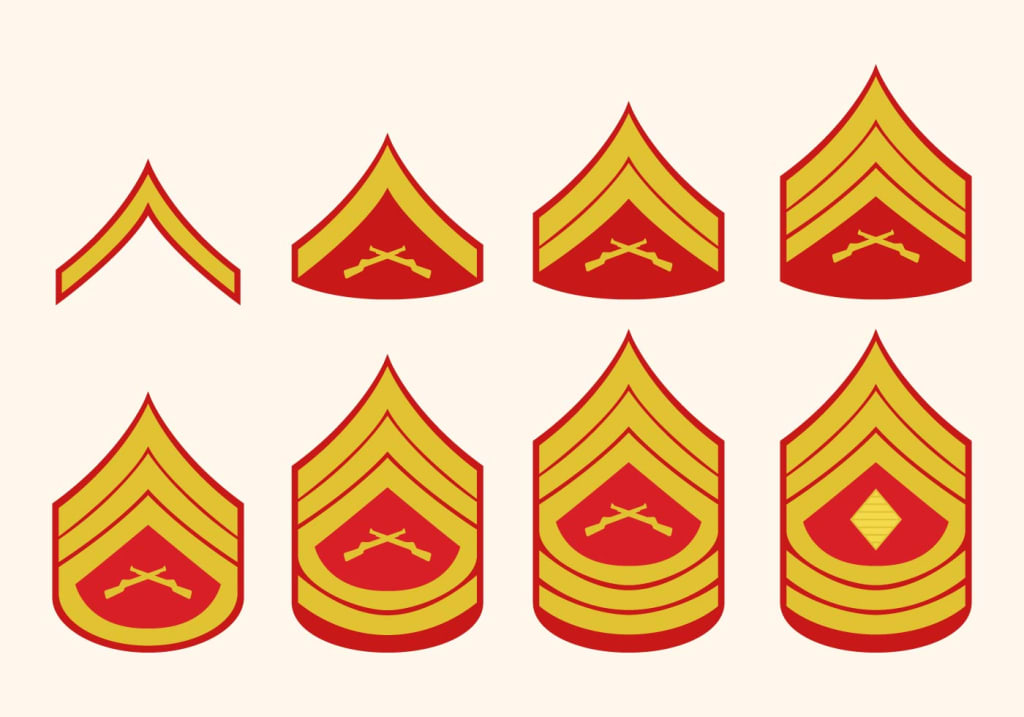What Are the Marine Corps Ranks?
If you know someone in the Marines, or are struck by some innate curiosity, chances are you've inquired it before: what are the Marine Corps ranks? Below you will find, from first enlistment to seniority, the rungs of the most dangerous military force in the United States.

Ever wondered how war works? Was there a time when you were confused by the military's ranking system? Or, ever asked your USMC buddy: "What are the Marine Corps ranks?"
It can be especially difficult keeping track of the varying points of leadership within the U.S. military, and even more so for the Marines alone. It's not an uncommon question, especially with so many different sectors of the US military, each having their own system for ranking.
Whether you're in the military, know someone who is, or just want to know for your own benefit, the following gives a detailed understanding of the Marine Corps ranks and each position's responsibilities.
Junior Enlisted Ranks
When first enlisting into the Marines and completing basic training, soldiers are referred to as an E-1 Private (Pvt). These officers tend to be brand new recruits. They have no detailed insignia to show for their USMC involvement until reaching the next level. They follow orders, learn from their superiors, and craft themselves into the Devil Dogs they will soon become.
After six months of service, company commanders are allowed to promote these graduates to the title of E-2, Private First Class (PFC). Under this new insignia, soldiers are required to use what they have learned more fluidly, while still learning the ropes and developing their skills.
E-3, or Lance Corporals (LCpl), are given status by company commanders after finishing both their nine months of Time-in-Service, plus eight months of Time-in-Grade. These officers are grinding out their leadership skills so as to reach their full potential as enlisted officers in the marines.
Non-Commissioned Officers (NCOs)
To reach the rank of Non-Commissioned Officer (NCO), Marine Corps soldiers must first demonstrate leadership and engrained-fundamentals that comes with being a Marine. This would mean meeting basic eligibility requirements and competing in a Marine Corps-wide Composite Score competition.
Once these steps are fully met, an E-3 Lance Corporal Marine can then move on up the ranks to become an E-4 Corporal (Cpl). At this stage, soldiers are given much more responsibility as small unit leaders. Here, they must demonstrate prowess in the areas of professionalism, maturity, and an increased level of leadership.
From there, a Corporal must perform the identical step of an E-3 LCpl, but with much higher demands in the aforementioned areas of leadership, maturity, and overall responsibility. Once proven to be at the top of their game, soldiers are promoted to the level of E-5, or Sergeant (Sgt). The responsibilities of an E-5 Marine are quite similar to that of its NCO counterpart, but with much more of an in-depth detailing of character, responsibilities, and tactics.
Staff NCOs
The following degrees of prowess in the Marine Corps are proven by a selection board. Each applicant is given an idealized process of testing, wherein the board goes over their file and accomplishments in the hopes of discerning them superior among their class.
The first level of the Staff NCOs is the E-6 Staff Sergeant (SSgt). At this level, soldiers are encouraged to demonstrate a whole plethora of demands. Their accountability and responsibility is then heightened into their new role, normally working with one or two sergeants in developing a perfect squad of soldiers.
The following level, the Gunnery Sergeant (GySgt), is the E-7 of the Marine Corps. "Gunnies," as they're referred to in the Marines, have an entire list of responsibilities, ranging from training subordinates and enforcing standards, to maintaining their unit's appearance and ensuring supervision.
To be considered for the next role in the Marine Corps, E-7 Marines must file on their 'fitness reports' for a promotion into Master Sergeant.
Senior Enlisted Advisors
After achieving E-8 pay grade status, which is the First Sergeant (1stSgt) and Master Sergeant (MSgt). A First Sergeant in the Marine Corps is the principal enlisted advisor, which means he wields a powerhouse of leadership commands in line with a more relied-upon administrative role. Though they are more accountable, Master Sergeants have a little more independence in their command positions, mostly supervisory, occupational, and tactical specialties.
Much like the previous pay grade status, the E-9 level of the Marine Corps has a multi-level tier set, beginning with Master Gunnery Sergeant (MGySgt). Herein lies one of the most capable of men in the military, by far, showcasing not only a series of leadership and accountability aspects, but also deep involvement and sense of composure under pressure. They are not only highly motivated and efficient leaders, but extremely well versed in tactical formations, military insight, and other such necessities.
The Second level of the Marine Corps pay grade is the Sergeant Major (SgtMaj). This role is meant to be the principal commander of the Marine Commanders. These men are well-equipped with such identities as ability to act, highly motivated, quick thinking, accountable and knowledgeable, plus extreme prowess in the Marine Corps values.
Also known as the Sergeant Major of the Marine Corps, the last and final tier of the Marines has an unquestionable devotion to the tactics, ideals, and motivations that nay Marine shares, but exponentially modified to the highest degree. This officer not only has a proven background, solid leadership skills, and a wide berth of idealogical premises in tactics and command, the Sergeant Major of the Marine Corps would be as anyone would expect: capable, reliable, knowledgeable, and straightforward beyond a reasonable doubt. These are men who have shown their colors and bleed the Semper Fi motto without concern for anything but to uphold the Marine Corps standards.
After the Sergeant Major of the Marine Corps there is the acting Commandant of the Marine Corps (CMC), who will work closely with the joint chief of staffs in the white house and perform the duties associated with basically running the entirety of the USMC.
About the Creator
Donald Gray
Politics may be a disgusting battlefield, but it is a necessary vice in our country, and a particular fancy of mine, like productivity and success. These are important facets in the modern world, and must be expounded upon.






Comments
There are no comments for this story
Be the first to respond and start the conversation.